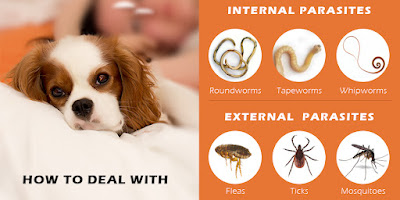Pets are always prone to two types of parasites. One is internal parasites and the other is external parasites. Most pet parents are well aware of external parasites whereas many must not be aware of internal parasites. Let us get into detail about knowing internal as well as external parasites.
External Parasites
You are most probably aware of the external parasites like fleas, ticks, mites, mosquitoes and lice. Apart from these pests, there are a few others that may infect your furry pals. Fire ant, Sarcoptic mange mites, Cheyletiella, Chiggers and Cuterebra fly and others.
Among these various external parasites, ticks are the most dangerous as these insects carry diseases like Lyme disease and Rocky Mountain fever. These pesky insects need to be treated as soon as possible before they can severely damage the health of your furred companion.
Insecticides and parasitic preventive treatments are the best that help in treating and controlling the parasitic infestation. If your pet constantly scratches or if you find flaky dry skin, rashes, inflammation, hair loss, redness on the skin or swelling, consult with your vet. After diagnosing, your veterinarian can provide you the best solution. It is also important to find which pet care supplies are crucial for your pet and the grooming options to select to protect them from harmful infestation.
With the constant influx of the external parasites during the change of seasons, it is quite difficult to completely eradicate these parasites. However, with the persistent use of monthly flea and tick preventives or insecticides, you may keep a check on the infestation and further prevent future flea, tick or mite infestation.
Apart from grooming and treating your pet, it is crucial to treat your house and surroundings as well with flea treatments. Flea bombs and flea yard sprays are highly useful in avoiding these external parasites around your environment.
Internal Parasites
Usually internal parasites are spread due to ingestion. Some of the most common internal parasites are –heartworms, hookworms, whipworms, lungworms, roundworms, tapeworms, hydatid tapeworms. Apart from these parasites, the other internal parasites (not so common) that may affect your furry friends are Giardia, Coccidia and stomach worms.
Roundworms are easily spread from infected animals, usually in filthy conditions. To control these worms, regularly use deworming treatments and talk to your vet if you find anything unusual with your furry pal.
Tapeworms are normally seen in pet’s feces, a kind of grains of rice and cause diarrhea and weight loss. Fleas with tapeworms when ingested by your pet cause this infection. They are also picked by unclean environment and infected animals. Deworming at an interval of 3 months will help in treating and preventing this disease. Moreover, flea preventive should also be used in order to control tapeworm infection.
Whipworms are highly dangerous as they suck blood from the large intestine, mainly in dogs. They lead to anemia and low protein level in dogs and cats. Pets are infected with whipworms when they ingest these larvae from the contaminated soil. These larvae take 3 months to become disease causing adults. Picking up the feces and keeping the environment clean help in controlling whipworm infection. A 3-month deworming plan is crucial to prevent reinfestation of this disease.
It is quite tough to avoid all the parasites all the times. However, following certain steps and taking preventive measures along with treating pets with flea and tick treatments, dewormers and other insecticides enormously help in controlling parasitic infections. With balanced pet diet, proper grooming and quality pet supplies, you can easily take care of your furry pal and help him/her to stay healthy.

No comments:
Post a Comment